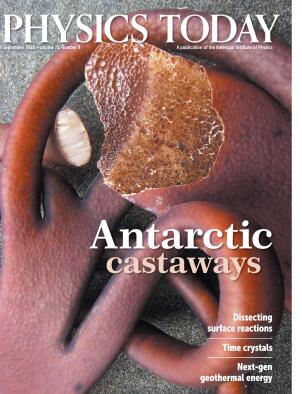Origins of meteorite organics
DOI: 10.1063/PT.3.4031
Early in the evening on 14 May 1864, a giant fireball streaked across the sky of southern France and exploded into some dozens of known fragments above the village of Orgueil. The largest piece, shown here, is a few kg and is on display at the French Museum of Natural History in Paris until January 2019. Among meteorites, the Orgueil bolide is classified as a carbonaceous chondrite because of its high carbon content, most of which is in small, dispersed regions of organic matter. Carbonaceous chondrites formed from accreting dust grains in the earliest days of the solar system. The Orgueil meteorite and others like it originated in the cool, outer reaches of the protosolar nebula, where they retained their water ice and other volatile and organic components. Those organic molecules provide key insights into essential building blocks for life on Earth, yet their origin remains contested.

Isotopic analysis offers important clues. Romain Tartèse of the University of Manchester and his colleagues now report isotope measurements of the oxygen contained in organic material from the Orgueil meteorite and two other carbonaceous chondrites. Interstellar and interplanetary processes have different dependencies on isotope mass fractionation, and oxygen’s three stable isotopes allowed the team to distinguish between the processes. Focusing only on the organic matter is challenging, however, due to the meteorites’ high prevalence of oxides and silicates. So in their investigation, the researchers combined two secondary ion mass spectrometry techniques—one with high precision and one with high spatial resolution. The resulting oxygen isotope ratios suggest that the organics formed early in the formation of the solar system, rather than either earlier, in the interstellar medium, or later, during hydrothermal alteration of the meteorites’ parent bodies. (R. Tartèse et al., Proc. Natl. Acad. Sci. USA, 2018, doi:10.1073/pnas.1808101115
To submit candidate images for Back Scatter visit http://contact.physicstoday.org
